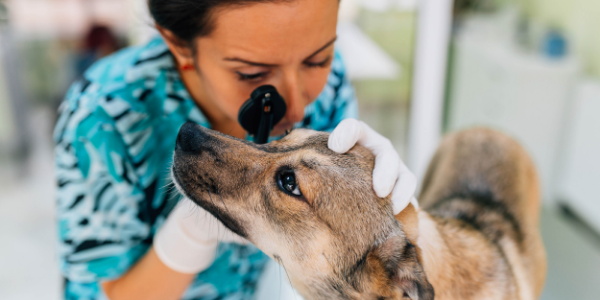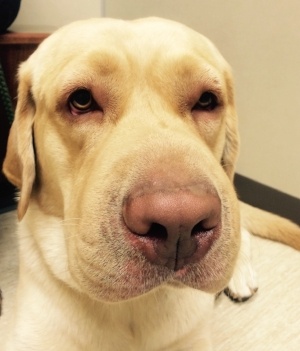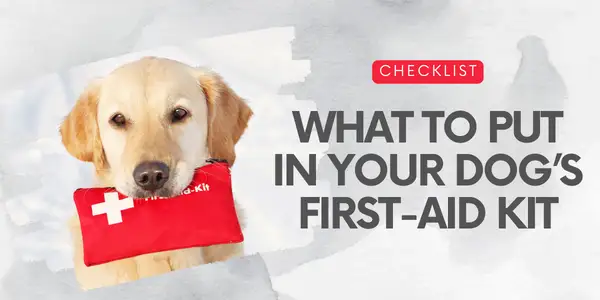 There is nothing more frightening than suddenly noticing something wrong with your sweet pet.
There is nothing more frightening than suddenly noticing something wrong with your sweet pet.
The first impulse is to panic and rush your dog to the veterinarian. In some cases, this may be the thing to do. Not the panic part! But rushing to the vet may be necessary. But when is something a true veterinary "emergency” for your dog?
There are situations that may be worrisome but do not require immediate care. As a veterinarian, I want your pet to receive the best care as soon as possible so that they don’t suffer more than they have to.
But how do you know if it’s an emergency? Do you wait to see your regular veterinarian when they’re open next or rush to the ER? Or do you simply just wait it out and hope things get better?
I have had to seek emergency care for my own animals before. Being on the other side of the emergency room doors is scary, and I empathize with that helpless feeling when your fur baby isn’t well. Hopefully, these tips and insights will help guide your decision-making.
What is Considered an Emergency for Your Dog?
If Your Dog is Hit by a Car
If your dog has been hit by a car, they should always be examined, even if they seem fine or the injuries don’t seem serious. Some injuries are not immediately visible. Even if your pet is walking around after being hit, you need to get them immediate care.
A shock of adrenaline can hide internal injuries like a ruptured spleen or bruising of the lungs. Prompt attention now can save your dog’s life later.
What to Do if Your Dog is Hit by a Car
- If your pet is bleeding, apply gentle pressure with a clean towel.
- Try to keep your pet still by wrapping them gently in a blanket. Be very careful; injured animals may inadvertently bite even people they know due to fear and pain.
- Have a neighbor, friend or passerby call your veterinarian to let them know you are on your way. This ensures they’re ready for you as soon as you arrive.
 If You Suspect Your Dog Has Bloat
If You Suspect Your Dog Has Bloat
If your dog’s stomach is distended, or if they seem anxious or are repeatedly trying to vomit with no luck – your dog is likely suffering from Gastric Dilatation and Volvulus (GDV), also known as "Stomach Torsion" or “Dog Bloat.”
This condition applies mainly to large breed, deep-chested dogs like Great Danes, German Shepherds, and Greyhounds.
Signs of Bloat in Dogs:
- Swollen or distended abdomen
- Attempts to vomit or retch with no success
- Pacing
- Panting
- Excessive drooling
- Taking a “play bow stance” – front elbows on the floor and hind end in the air
What to Do if You Think Your Dog Has Bloat
DO NOT ATTEMPT TO FEED YOUR DOG OR GIVE THEM WATER. Get your dog to a veterinarian immediately – delaying care will make a difference between life and death. If not treated immediately, your dog's stomach can flip and block blood flow to the rest of the intestines, reducing their chance of survival. If you're considering giving your dog Gas-X because you've heard it might help, don't! It won't help for bloat.

If Your Dog is Bleeding
Any bleeding from your dog that is continuous or severe needs to be seen by a veterinarian. Any wound that is "full-thickness," which means it goes all the way through the skin, and you can see underlying muscles and tissues, tendons, or nerves, should be evaluated by a veterinarian right away.
Even if the bleeding is from a puncture wound, you should seek veterinary care. Bite wounds or punctures from wood sticks can cause nasty abscesses. Prompt veterinary care will prevent complications, such as infection.
An animal that is bleeding, lethargic or weak, and with pale gums, can mean severe blood loss and is an immediate veterinary emergency.
What to Do if Your Dog is Bleeding
Listed below are things you can do until you can get to your vet or on the way by car:
- Applying direct pressure on the wound with a clean towel, gauze pad, or a feminine napkin can stop the bleeding. Do not keep lifting the material covering the wound, or it can disrupt the clotting process. If blood soaks through, just keep adding more material and pressure.
- Should you use a tourniquet on your dog? The use of a tourniquet is potentially dangerous and should only be used for life-threatening hemorrhage in a limb. So, if you see blood spurting or pumping from a wound, you can use this technique.
Use a piece of cloth, towel, or nylon leash and wrap it around the limb once or twice, just above the wound, and tie it into a knot. Tie another piece of material on top of the knot.
Every 20 minutes loosen the tourniquet for 15 to 20 seconds because leaving it on too long can cut off blood supply. This is potentially dangerous and can result in the need to amputate the limb.
Remember, a tourniquet should only be used as a last resort. It should only be used if you are more than 10–15 minutes from an emergency veterinary clinic and there is blood spurting or pumping from the wound.
If Your Dog Has Trouble Breathing
Breathing fast is different than difficulty breathing or respiratory distress. One is an emergency, and one may not be.
An elevated respiratory rate or panting can happen if a dog is excited or nervous or has been exercising. Respiratory distress means that the act of breathing is difficult, and your dog may be reluctant to move. You may hear wheezing or whining as your dog attempts to breathe. This can come on without exercise or stress.
Watch this video to learn how to check your dog's respiratory rate:
Symptoms of Respiratory Distress in Dogs:
- Panting that is constant and accompanied by blue-tinged or pale gums
- Constant coughing and stretching out the neck to try to breathe
- Sitting up with the front legs spread while breathing/panting
- Abdominal breathing – the sides of the stomach appear to be moving in and out forcibly while breathing
- Foamy or froth discharge from the mouth
What to Do if Your Dog Has Difficulty Breathing
During an episode of respiratory distress, try to stay calm and keep your pet calm. Talk to them in a soothing voice. Bring any medications your pet is on with you to your vet. Having a family member, friend, or neighbor call ahead to the vet can help the clinic be more prepared for your arrival.
If Your Dog Has Ingested Poison or Toxins
This is a broad topic, and while some toxins may cause minor digestive upset, others can be lethal if not treated immediately. If you see your dog ingest a toxin, you could call your veterinarian or emergency vet clinic and ask for their advice. They’ll let you know if the toxin ingested is something to be concerned about and whether your dog needs to be seen right away.
You can also call a poison hotline for assistance. There is often a fee for the poison control hotline services.
Be sure to take the container the toxin was in with you when you go to the vet or ER. Or grab a photo of the ingredient label to show them. If you suspect toxin ingestion and your dog is vomiting, bring a sample of the vomit with you to help your vet identify the toxin.
Do not attempt to induce vomiting with hydrogen peroxide unless directed to by your veterinarian or a poison control hotline. Too much hydrogen peroxide can cause problems like aspiration pneumonia or gastric ulcerations – and sometimes the toxin can do more damage coming back up.
Most Common Dog Toxicities That Require Immediate Care
- Chocolate – If a Labrador Retriever ingests a few Hershey’s Kisses, it is usually not a big deal. But if a two-pound Chihuahua does, it may be an emergency. If that same Labrador eats a bar of baking cocoa … that is a big deal! Milk chocolate is much less toxic than baking chocolate, and the severity of signs is based on how much was ingested and the size of your pup.
- OTC and prescription medications – Advil, Tylenol, antidepressants, vitamins, birth control pills – these can all be toxic to your dog.
- Human foods like grapes, onions, garlic, macadamia nuts, and the low-cal, diabetic-friendly sweetener xylitol can all cause serious toxicities in dogs and cats.
- Veterinary medications – even those drugs prescribed to make your pet better can cause serious issues when ingested in large amounts.
- Household items – gorilla glue, paint, and cleaning products should all be kept out of reach of pets.
- Plants – some plants only cause digestive upset like vomiting or diarrhea. Others, like the Sago Palm, can cause serious organ damage if not treated immediately.
- Rodenticides – rat and mouse bait is usually sweet-tasting to both rodents and pets, and if not treated immediately, can cause serious bleeding issues.
If Your Dog Has Eye Problems or an Eye Injury
While a non-painful eye with a small amount of discharge is not a veterinary emergency for your dog, some eye issues require immediate care. Knowing the difference is important!
Signs that your dog's eye issue is an emergency:
- Pain – evidenced by pawing at the eye, squinting, sensitivity to light
- Swelling of the eyelids accompanied by redness and or discharge, especially yellow or green in color
- The sclera (whites of the eyes) are extremely red, accompanied by symptoms of pain noted above
- One eye looks bigger than the other or is “bulging”
- A sudden change in color to one or both eyes
With eye emergencies, it is best to get your pet seen by a veterinarian ASAP. You can place an Elizabethan (cone) collar to prevent your pet from causing more trauma to a painful eye by rubbing it until they can be seen.

If Your Dog is Unable to Urinate
If your dog cannot pass urine, that is an emergency! You should contact your veterinarian or emergency clinic immediately. Male dogs can become blocked if crystals or stones become lodged in their urethra. It is much more difficult for female dogs to be “blocked.”
Female dogs may strain to urinate if they have a urinary tract infection, crystals in their urine, or bladder stones. They should still be examined as soon as possible, but it is rarely an emergency.
Symptoms your dog may have a urethral blockage or an inflammatory process making urination difficult or painful:
- Straining to urinate but producing no urine
- Asking to go out multiple times a day with only small drips of urine produced.
- Licking at the genitals frequently
- Bloody urine
If Your Dog Has a Seizure
A seizure episode is described as shaking, tremors, paddling with the legs, and sometimes loss of bowel or urinary control. While always scary to witness, a single seizure episode is not necessarily an emergency.
There are also “seizure type” behaviors like biting at the air, staring into space, or seeming “out of it." These warrant a veterinary exam but are not usually an emergency.
Signs that a dog's seizure is cause for emergency care:
- The seizure is lasting for more than 4 to 5 minutes
- Multiple seizures happening in a 24-hour period (called “cluster seizures”)
- Your pet does not seem to “come out of it” and is not “back to normal” after the episode
- Any seizure that is associated with a toxin ingestion
If your dog is seizing and will not stop, you can try turning down the lights or placing a cloth lightly over their eyes. Try to talk to them in a soothing voice and make sure they are not in a position to fall off of anything, like the bed or couch.

If Your Dog Has an Allergic Reaction
Luckily most allergic reactions in dogs are mild (itchiness, mild swelling of eyes or muzzle) and not life-threatening. But dogs can have severe anaphylactic reactions just like people.
The most common causes of these types of severe reactions are from bee or wasp stings, spider bites, medications, or even vaccines. A true anaphylactic reaction requires absolute immediate attention by your veterinarian or the ER vet clinic.
Signs of an allergic reaction in your dog:
- Sudden collapse
- Facial swelling
- Swollen eyes
- Pale or bluish mucous membranes
- Difficulty breathing
- Seizures
This is only a partial list of some of the more common dog emergencies. You are the best judge of your pet’s health. If you think something is an emergency, then it is, and the best thing you can do is call your vet or emergency clinic.
They are there to help decide if your pet should be seen immediately. It is always better to be safe and have things checked out rather than wait. It could mean the difference between life and death for your beloved animal companion.






